Related Research Articles

Darna is a superhero appearing in Filipino comic books created by writer Mars Ravelo and artist Nestor Redondo. The character was introduced during the Golden Age of Comic Books, debuting in Pilipino Komiks #77 on May 13, 1950. Darna is a retooling of Ravelo's earlier character, Varga, who first appeared in 1947. With her continued presence in literature and art, Darna has been described as a Filipino cultural icon. Throughout the years, she has been adapted to a number of media platforms, such as film, television, plays and video games.
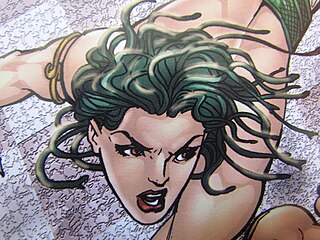
Valentina is a supervillain appearing in Philippine comic books, created by Mars Ravelo and Nestor Redondo. Based upon the eponymous Greek mythological figure, she first appeared in Pilipino Komiks and was the first adversary of the superhero Darna. Referred to as the "Goddess of Snakes", she has command over all kinds of serpents and has venomous snakes in her head instead of hair. She has been featured significantly as Darna's archenemy in many adaptations of her stories in other media.
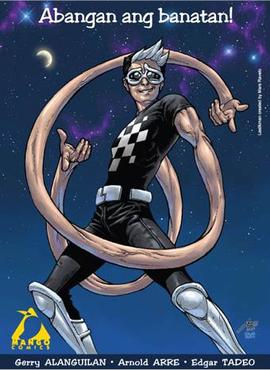
Lastikman, originally spelled Lastik Man, is a fictional character and Filipino comics superhero created by Mars Ravelo and artist Mar T. Santana. Lastikman or the original spelling of Lastik Man debuted in comics format in Aliwan Komiks #56. Based on DC Comics' Plastic Man, and/or Marvel's Mister Fantastic from Fantastic Four, Lastikman can also stretch and transform into many imaginable forms and shapes he desires.

Lauro "Larry" Zarate Alcala was a well-known editorial cartoonist and illustrator in the Philippines. In 2018, he was posthumously conferred the National Artist for Visual Arts title and the Grand Collar of the Order of National Artists.

Doroteo Gerardo N. Alanguilan Jr., also known in the Philippines by his alias Komikero, was a Filipino comic book artist, writer, and architect from San Pablo, Laguna. He was an important figure in the Philippine comics renaissance of the 1990s and early 2000s, and is known internationally for his graphic novels Wasted and Elmer, and for his inking on American superhero comics such as Wetworks, X-Men, Superman: Birthright, Wolverine, and Fantastic Four.
Philippine Comics have been popular throughout the nation from the 1920s to the present. Comics scholar John A. Lent posited that the Philippine comics tradition has "the strongest audience appeal, best-known cartooning geniuses, and most varied comics content" in Asia after Japan and Hong Kong.
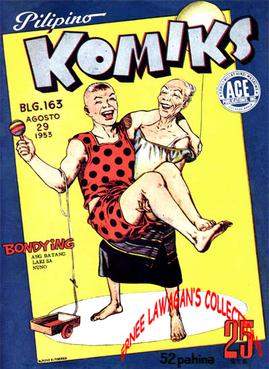
Bondying is a comic book character created by Filipino graphic novelist Mars Ravelo and first introduced by Pilipino Komiks on August 29, 1953. He is a large person who is still considered a baby.
Zuma is a Filipino comic book character created by Jim Fernandez in 1974. The character first appeared in a serial written by Fernandez entitled Aztec. From 1976 to 1985, Zuma got his own series named Anak ni Zuma that was serialized in Aliwan Komiks published by Graphics Arts Service Inc. with illustration by Ben Maniclang. The comics series was the biggest best seller for Aliwan. Following this publication success, spin-offs and a 1990s reboot about the character were published and it was further expanded in other media including film and television.
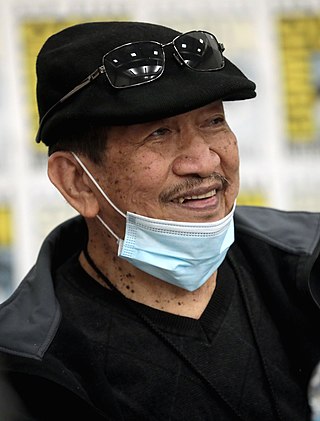
Alex Niño is a Filipino comics artist best known for his work for the American publishers DC Comics, Marvel Comics, and Warren Publishing, and in Heavy Metal magazine.
Filipino animation, also known as Pinoy animation, is a body of original cultural and artistic works and styles applied to conventional Filipino storytelling, combined with talent and the appropriate application of classic animation principles, methods, and techniques, which recognizes their relationship with Filipino culture, comics, and films. It also delves into relying on traditional and common Filipino "sense of going about things" or manner of coping with Filipino life and environment.

Francisco V. Coching was a Filipino comic books illustrator and writer and is regarded as one of the “pillars of the Philippine Komiks Industry”. He served as both illustrator and writer for his comic book stories, Coching is referred to as the "King of Komiks", and as the "Dean of Philippine Comics". In 2014, he was posthumously conferred as a National Artist for Visual Arts, the highest honor for artists in the Philippines.
José Zabala-Santos, nicknamed as "Mang Pepe" by hometown neighbors and as "Zabala" by colleagues in the cartooning profession, was a successful cartoonist in the Philippines and was one of the pioneers of Philippine comics. He became one of the most popular cartoonists in the Philippines during the 1950s because of his cartoon characters such Popoy, Sianong Sano, and Lukas Malakas. Zabala is one of the "respected names" of artists in the Philippine cartoon and comics industry.

Francisco "Kenkoy" Harabas is a Philippine comics character created by writer Romualdo Ramos and cartoonist and illustrator Tony Velasquez in 1929. Velazquez continued the strip for decades after Ramos' death in 1932. Kenkoy was seminal to Philippine comics and thus Velasquez is considered the founding father of the komiks industry. The term kenkoy has entered the Filipino language to mean a joker, jester, or a hilarious person.
Dominador "Hal" Santiago (August 9, 1941 – February 21, 2021) was a Filipino illustrator and writer in the field of Philippine comics. Santiago was described by Filipino writer Jim M. Fernandez as the “Raphael of [Philippine comic book] Illustrators”. His illustrations for eight comics series made him one of the most prolific Filipino comic illustrators, second only to Mar T. Santana, who has illustrated 17 series.

Voltar was a comic strip title and comic book character created, written, and illustrated by Filipino illustrator Alfredo Alcala in 1963. A story about Vikings, Voltar was first published in the Philippines by CRAF Publications, a comic book company established by Alcala himself, together with other colleagues in the field of comics such as Virgilio Redondo, Nestor Redondo, Amado Castrillo, and Tony Caravana, among others. Voltar was described as one of the most spectacular comic strips to ever appear in Philippine comics.

Ukala (Ang Walang Suko), meaning "Ukala (The Unrelenting)" [i.e. the one who doesn't give up] was a comic strip title in Philippine comics. The main character in the comic book story is Ukala. Ukala was created in the 1950s by distinguished Filipino illustrator Alfredo Alcala. Ukala, the character, was a Native American Indian or "Amerindian". The story, written and illustrated by Alcala for Filipino readers, was about the adventures of Native American Indians set at a timeline when the first Europeans arrived in the Northwestern region of the Americas. Ukala was adapted into film as Ukala (Ang Walang Takot), meaning "Ukala (The Fearless)" in the Tagalog language. It appeared on the pages of the Philippine comic book named Pilipino Komiks. It had been made into movie by Sampaguita Pictures, directed by Artemio B. Tecson in 1954. Leading performers were Cesar Ramirez in the title role and Alicia Vergel as Margarita.
Pilipino FUNNY Komiks or simply Funny Komiks is the oldest running comic book publication for children in Philippine comics history. It first went into print on June 26, 1978. It was published by Islas Filipinas Publishing Co., Inc.
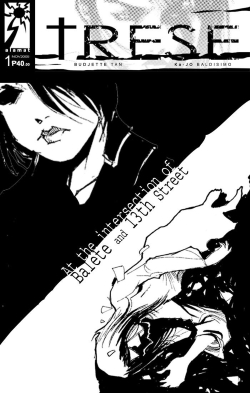
Trese is a Filipino komik series written by Budjette Tan and illustrated by Kajo Baldisimo. It tells the story of Alexandra Trese, a detective who deals with crimes of supernatural origin. Its first issue was published on October 22, 2005, starting off as a niche work which grew in popularity as readers were intrigued first by the first two volumes' focus on Manila's urban legends, and then by the later volumes' development of Alexandra Trese as a character. The series went on to win several accolades.